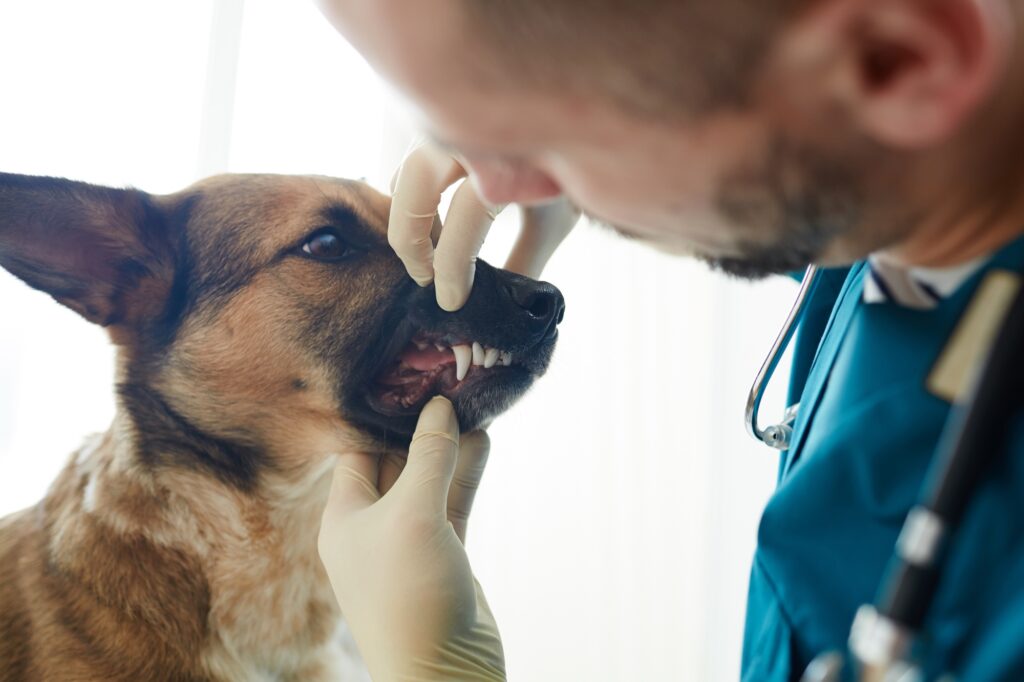Jaw Fractures occur secondary to trauma, severe periodontal disease, cancer, or metabolic disease. It is diagnosed by physical exam, bloodwork, and skull or dental x-rays.Treatment involves pain control and restoring proper occlusion and ability to eat. This can involve a therapeutic muzzle, canned/pureed diet, or surgical correction.
Malocclusion is an abnormal position of the teeth affecting normal alignment of the jaw. Diagnosis is based on oral examination. Therapy involves ensuring the pet is free from pain and has a functional bite. This may involve in no treatment, extraction of teeth, or orthodontic treatment.
Oral Neoplasia is cancer of the oral cavity that can be benign, locally invasive, or malignant. Oral tumors in cats are rarely benign. Clinical signs include the owner visualizing the tumor, pet having difficulty chewing, hypersalivation, malodor, and bleeding from the mouth. Diagnosis is based on oral examination, bloodwork, x-rays or advanced imaging, and biopsy of the mass. Treatment depends on the type of tumor diagnosed, but can include pain control or palliative therapy, removal of the mass, jaw resection, or radiation therapy.
Oronasal Fistula is a connection between the oral and nasal cavities as a result of severe periodontal disease. The upper canine teeth are most often affected. Clinical signs include nasal discharge, sneezing, or malodorous breath. Diagnostic testing involves an oral examination, bloodwork, x-rays, and a thorough dental examination under anesthesia. Treatment includes extraction of the affected tooth, oral antibiotics, pain medication, and closure of the fistula.
Periodontal Disease is inflammation and infection of the gingiva, periodontal ligaments, and alveolar bone surrounding the tooth root. Clinical signs include malodorous breath, difficulty chewing, no longer chewing hard toys, loose teeth, and general malaise. Diagnosis is based on oral exam, bloodwork, and a thorough dental assessment and x-rays under anesthesia. Treatment can include pain medications, oral or local antibiotics, and extraction of the affected teeth.
Resorptive Lesions in Cats is progressive loss of the tooth as a result of resorption. Clinical signs can include difficulty chewing, decreased appetite, and hypersalivation. Diagnosis is made by an oral exam. Pre-operative bloodwork is often performed. Treatment includes a thorough dental exam, dental x-rays, and extraction of the affected teeth.

Retained (Persistent) Deciduous Teeth is a condition where the “baby” teeth fail to come out on their own. There is a higher prevelance in small or toy breed dogs. This can lead to periodontal disease, malocclusion, malposition of permanent teeth, or trauma to the gingiva. Diagnosis is made through an oral examination. Treatment involves extraction of the deciduous teeth.
Salivary Mucocele occurs when saliva leaks and accumulates into the tissue surrounding the salivary gland. Clinical signs depend on location of the salivary gland affected. There can be a swelling of the side or under the jaw or tongue. This can cause hypersalivation, difficulty chewing, or reluctance to eat. Diagnostic testing includes a fine needle aspirate for cytology or, rarely, a sialogram. Treatment depends on location. Draining or excising the affected salivary gland may be performed. If it is located under the tongue, then marsupialization (suturing open) of the gland is performed. There is recurrence if incompletely removed.
Stomatitis is inflammation of the mouth that leads to oral ulcers. This may be associated with a virus in cats and hereditary in Maltese dogs. Clinical signs include reluctance to eat or anorexia, weight loss, difficulty chewing, malodor to breath, bleeding from mouth, and a painful mouth. Diagnostic testing involves bloodwork, viral blood testing, oral examination under anesthesia, dental x-rays, and extraction of teeth. The inflammation and ulceration often resolve with complete extraction of teeth. Some pets may also require antibiotics and immunosuppressive medications.
Temporomandibular Joint Luxation is complete displacement of the condyle of the mandible out of its fossa as a result of trauma, fracture, or dysplasia. Clinical signs include an inability to close the mouth, painful when chewing, reluctant to eat, and an audible click when opening the mouth. Diagnostic testing includes bloodwork and skull x-rays. Advanced imaging may also be performed. Treatment involves manual reduction of the condyle in the fossa, a therapeutic muzzle, feeding soft/canned food, or in more severe cases surgical removal of the condyle may be performed.
Tooth Fractures occur following trauma. Uncomplicated fractures may not require treatment. Complicated fractures with pulp or root exposure require treatment. This can include removal of the pulp, capping and restoration, or extraction of the affected tooth. Other therapy includes oral antibiotic and pain medications.
Tooth Root Abscess is an infection at the periapical region of the tooth. Clinical signs include a painful tooth, reluctant to eat, hypersalivation, swollen or reddened gum, or fever. Diagnosis is made with an oral examination, bloodwork, and dental x-rays. Treatment involves extraction of the affected tooth, oral antibiotics, and pain medication.
Unerupted Teeth are teeth that have not emerged into the oral cavity. The tooth appears to be missing. Diagnosis is made with dental x-rays and can be associated with cyst formation. The unerupted tooth may be encouraged into its proper location with orthodontic procedures or extraction of the tooth and the surrounding area may be necessary.
